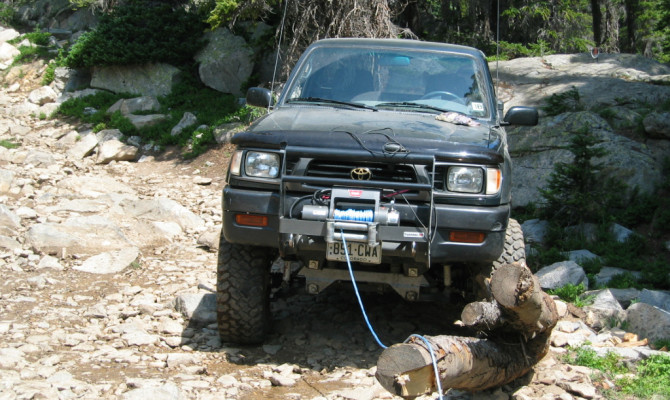There have been very few times that I have gone four wheeling and not run into a situation where a winch is required.
A winch can be an important tool in safely plucking a vehicle from an impossible situation, or righting a truck after a rollover. It can also be used to clear properties of logs or rocks. If you travel the back-roads of British Columbia, you should never be without a winch.
There are a few things to know before you operate your winch for the first time. What appears to be a simple operation can quickly turn dangerous if basic safe winching practices are not used. Most are equipped with a varying length of wire rope and the length of the rope is determined by the winch’s load capacity. The wire rope should be inspected regularly to ensure that it has not become crushed, pinched, frayed, or kinked at any point. Should the rope be damaged, it should be replaced before use to avoid injury.
All winch owners should have a winch accessory kit to recover a vehicle properly and safely. The average kit includes a three-metre chocker chain, a clevis, snatch block, five-centimetre tree trunk protector, gloves, and a carrying case.
Prices are generally between $250 and $375 depending upon the manufacturer. Most winches are offered with a winch hook strap to ensure that operators do not put hands and fingers in harm’s way. Always wear gloves when operating a winch or handling wire rope.
A single line pull is one of the most basic winching operations. It involves rigging the wire rope to a stable anchoring point and spooling it in to pull the vehicle toward the anchor point. This type of pull can also be used to extract a truck without a winch; the winch equipped truck becomes the anchor point and the stuck vehicle is pulled toward it. It is a good idea to throw a jacket or blanket over the wire rope midway between the winch and the anchor point. This will prevent the cable from whipping back to the truck in the event of breakage. A tree can serve as an excellent anchor point, but never attempt to wrap a wire rope or chain around it. In addition to being extremely dangerous, this improper winching practice can damage or kill the tree. Use a tree saver strap, along with a clevis.
When a truck is seriously stuck, more winching power can be achieved through a double line pull. To do so, un-spool a length of a line from the drum and thread it through a snatch block. The cable’s hook can then be fastened to an anchor point on the trucks frame or tow hook, and the snatch block will secure to an anchor point toward the direction of the pull. This method decreases the number of layers of wire rope on the drum and greatly increases pulling power.
A snatch block can also be used to change the direction of the pull, without the wire rope collecting on one side of the drum. If you have followed the basic principle of four-wheeling and brought a buddy or a second vehicle, then chances are you will have some assistance in the recovery.
Sometimes all a stuck vehicle needs is a little motivation. In those instances, a quality recovery strap ($53) will work fine. Knowing how to operate a winch correctly is as important as knowing how to drive the 4×4 it is mounted to. Misuse can result in injury or even death, so it is a good idea to familiarize yourself with your winch before reaching a situation where you need to use it.
Recent Comments
- { Enjoyed your Forest of Bowland in the BMW X5M, particularly the photo of the BMW in front of the main part of Stonyhurst College where... }
- { Bantam designed the Jeep, not Willy's or Ford. The American military gave the original Bantam prototype to Willys and Ford to copy. There is plenty... }
- { All Escalades come with a 6.2-lilter V8 engine that produces 420 horsepower. A six-speed automatic is the only transmission offered and drives the rear wheels.... }
- { Alexandra is an excellent journalist. }
Popular Posts
- Journey to a ‘Sparkling’ Luxury Okanagan Resort “Four lucky readers will put a Dodge Journey’s weekend-...
- The Need For Speed: Hike Those Highway Limits More than half of those polled believe the province sho...
- Drives-U-Crazy… Erratic drivers. An early morning drive from Kelowna to Vancouver is nor...
- Readers Respond: The Pros and Cons of Increasing B.C. Speed Limits Increasing the speed limits will only increase risk to...
- Honda CR-V Review: The Compact Crossover To Get Things Done The CRV is a very stylish and aerodynamic crossover veh...







